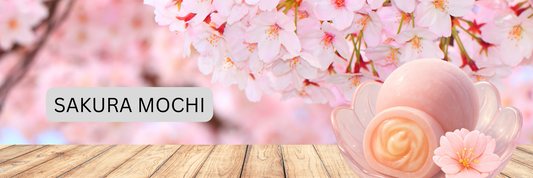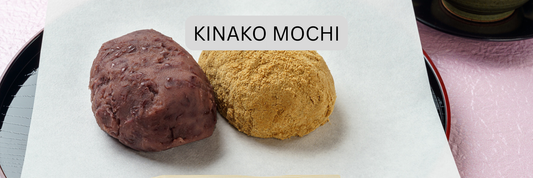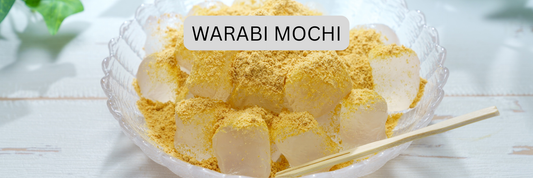If you’ve ever strolled through a Japanese summer festival or browsed traditional dessert shops in Kyoto, you’ve likely come across Warabi Mochi a translucent, jelly-like sweet that’s as refreshing as it is elegant. Unlike the chewy rice-based mochi we often see, warabi mochi has its own unique texture and history that make it a favorite among locals and travelers alike.
- Types of Mochi: Complete Guide to Japanese Mochi Varieties
- Mochi Ice Cream: History, Recipes, Flavors & Everything You Need to Know
- Is Mochi Healthy? – A Complete Health Analysis
What Is Warabi Mochi?

Warabi Mochi (蕨餅) is a traditional Japanese dessert made from bracken starch (warabiko), water, and sugar. It has a soft, jelly-like texture that melts in your mouth, offering a delicate sweetness. Traditionally, it’s served chilled and coated with kinako (roasted soybean flour) or drizzled with kuromitsu (black sugar syrup) a perfect treat for hot summer days.
Although the name includes “mochi,” it’s not made from glutinous rice like regular mochi. Instead, it’s crafted from starch extracted from the roots of the bracken fern, giving it its signature bouncy and silky feel.
Warabi Mochi vs. Regular Mochi
While both desserts share the name “mochi,” they differ in ingredients and texture:
| Feature | Warabi Mochi | Regular Mochi |
|---|---|---|
| Main Ingredient | Bracken starch (warabiko) | Glutinous rice (mochigome) |
| Texture | Jelly-like, soft, smooth | Chewy, sticky, dense |
| Flavor | Light, subtle sweetness | Rich, rice flavor |
| Common Toppings | Kinako, Kuromitsu | Red bean paste, fruit, ice cream |
This makes warabi mochi a lighter and more refreshing option — ideal for those who enjoy less sugary, more natural desserts.
The History of Warabi Mochi
Warabi mochi dates back to Japan’s Heian period (794–1185), where it was enjoyed by nobles as a luxury delicacy. Because bracken starch was rare and expensive, the dessert symbolized elegance and refinement.
Today, modern versions often use potato starch or tapioca starch as a substitute for authentic warabiko, making it more affordable while preserving its traditional taste.
How to Make Warabi Mochi at Home

Making warabi mochi is simpler than you might think! Here’s a basic recipe:
Ingredients
- 50g warabi starch (or potato starch)
- 250ml water
- 30g sugar
- Kinako (roasted soybean flour)
- Kuromitsu (black sugar syrup)
Instructions
- Mix warabi starch, water, and sugar in a saucepan.
- Stir constantly over medium heat until the mixture thickens and turns translucent.
- Remove from heat and transfer to a mold.
- Let it cool, then refrigerate for 1–2 hours.
- Cut into cubes and coat with kinako or drizzle kuromitsu on top.
Where to Buy Warabi Mochi

You can find warabi mochi in:
- Japanese supermarkets or specialty stores.
- Traditional sweet shops (wagashi-ya) in Japan.
- Online Asian grocery stores like Amazon Japan, Rakuten, or Yamibuy.
- Cafés that serve matcha desserts.
In Kyoto or Osaka, street vendors often sell chilled warabi mochi in small cups a must-try for dessert lovers visiting Japan.
Variations of Warabi Mochi
Modern chefs have given warabi mochi a creative twist:
- Matcha Warabi Mochi – infused with green tea powder.
- Black Sesame Warabi Mochi – nutty and aromatic.
- Fruit-Infused Warabi Mochi – flavored with mango, strawberry, or yuzu.
- Frozen Warabi Mochi – served as a chilled summer dessert.
Warabi Mochi Nutrition Facts

While warabi mochi is lower in calories compared to other sweets, it still provides a gentle source of carbohydrates.
| Nutrient | Amount (per 100g) |
|---|---|
| Calories | ~120 kcal |
| Carbohydrates | 30g |
| Protein | 0.5g |
| Fat | 0g |
Since it’s gluten-free and low in fat, it’s a great light dessert option for health-conscious eaters.
Calories in Mochi: The Complete Guide to Nutrition, Health, and Low-Calorie Alternatives
FAQs
1. What does warabi mochi taste like?
It has a subtle sweetness, a jelly-like texture, and a nutty flavor from the kinako coating.
2. Is warabi mochi vegan or gluten-free?
Yes! Traditional warabi mochi is both vegan and gluten-free, made from starch, water, and sugar.
3. How long does warabi mochi last?
It’s best eaten fresh or within 1–2 days, as it loses its delicate texture over time.
4. Can warabi mochi be refrigerated?
Yes, refrigerate before serving to keep it firm and refreshing, but avoid long storage to maintain texture.
5. Is warabi mochi the same as jelly?
Not exactly. It’s softer than gelatin jelly and doesn’t use animal-based ingredients making it ideal for vegan diets.
Conclusion
Warabi Mochi isn’t just a dessert — it’s a taste of Japanese tradition. Its simplicity, elegance, and refreshing flavor capture the essence of Japanese summer sweets (wagashi). Whether you enjoy it in Kyoto’s teahouses or make it at home, this jelly-like delicacy offers a delightful glimpse into Japan’s culinary heritage.







